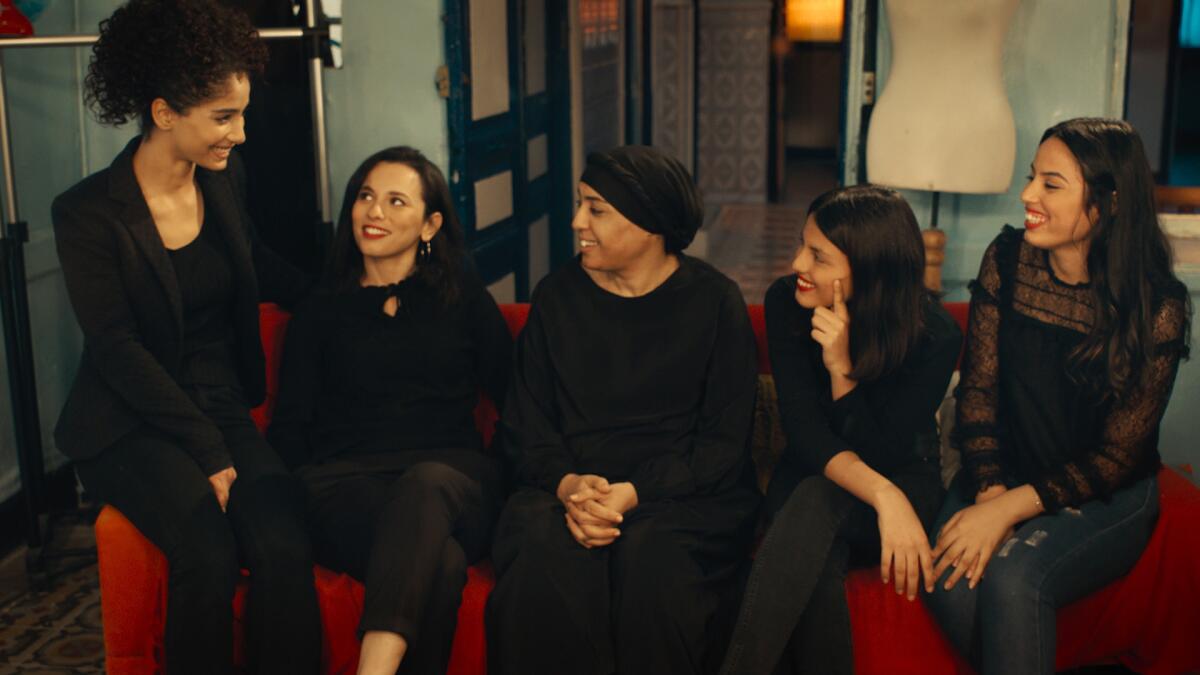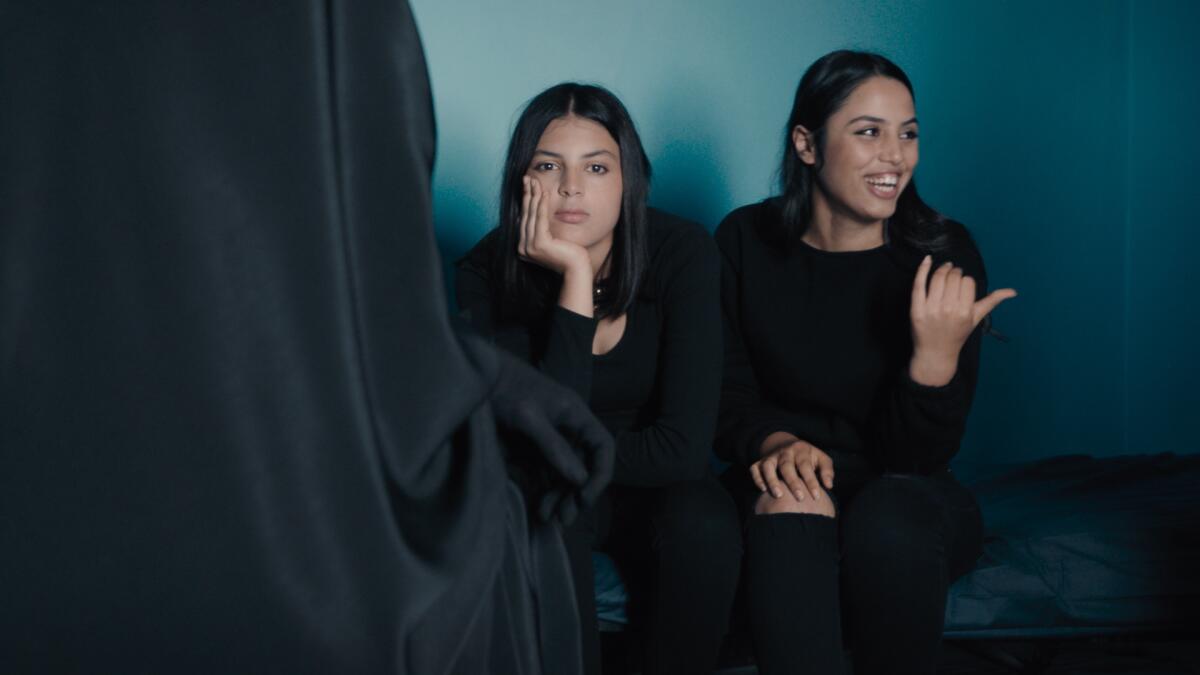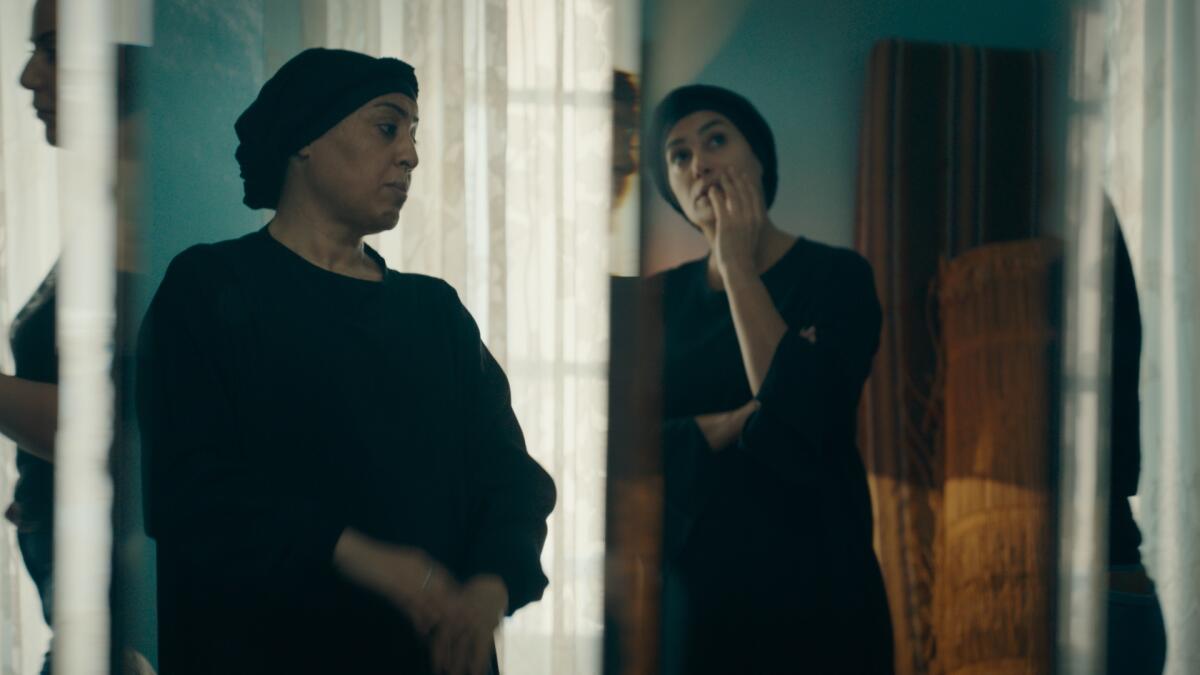The gripping ‘Four Daughters’ spotlights a shattered Tunisian Arab family

- Share via
In 2016, a Tunisian woman named Olfa Hamrouni went public with a personal story of loss, rage and despair: Her two elder daughters, teenagers Ghofrane and Rahma Chikhaoui, had recently fled home for Libya and joined Islamic State. They were hardly alone among the thousands of radicalized young Tunisians who had pledged themselves to militant groups abroad. But Hamrouni’s willingness to speak out, and to call out the local authorities for their indifference and inaction, was rare enough to generate headlines, boldly refusing the culture of shame that had forced others like her to stay silent.
On the evidence of “Four Daughters,” a formally daring, emotionally gripping new movie from the Tunisian director Kaouther Ben Hania (of the Oscar-nominated “The Man Who Sold His Skin”), Hamrouni has lost none of her outspokenness seven years later. If anything, she has passed it on to her two younger daughters, Eya and Tayssir Chikhaoui, who join her in recounting the mystery and tragedy of their sisters’ disappearance. They reminisce about good times and bad, sometimes with the wry comic distance that comes with age and sometimes with the agony of a fresh wound.
That pain commingles with a curious thrill when the women come face-to-face with two actors who have been cast as the older daughters. (Ichraq Matar plays Ghofrane; Nour Karoui plays Rahma.) What follows is part documentary account and part metafictional experiment, a willed mix of art and therapy that unfolds almost entirely in a series of rooms. Hamrouni, Eya and Tayssir describe Ghofrane and Rahma in detail for the actors, and then perform alongside them in reenactments of key moments from their past. In another touch of artifice, Ben Hania enlists the Egyptian Tunisian actor Hend Sabri to play Hamrouni in scenes that she might find too difficult to appear in herself.
At times Hamrouni avails herself of this option. More often, though, she finds herself in the frame with Sabri, providing crucial context, blocking the action and even hovering visibly in the background during shooting. A witty, chatty, naturally magnetic screen presence, Hamrouni seems to have had little trouble seizing control of her narrative or defying stereotypes of docile Arab Muslim femininity. One of the movie’s funniest, most satisfying moments is a reconstruction of Hamrouni’s wedding night, in which she refuses her groom’s clumsy advances and ingeniously subverts the traditional flaunting of a virgin bride’s defloration. (The actor Majd Mastoura plays her husband and the movie’s few other male roles of note.)

You have to applaud Hamrouni, in that moment and others, for literally bloodying the nose of the patriarchy. But as her conversations with Tayssir, Eya, “Rahma” and “Ghofrane” make clear, teaching her daughters how to be women in the world has proved to be far more difficult. Early on, Hamrouni declares that Ghofrane and Rahma were “devoured by the wolf,” a fable-like reference to Islamic State that obscures a more complicated, contradictory reality. Hamrouni acknowledges her own heavy-handedness in rearing her daughters, her sometimes violent eruptions of temper and her intense anxiety about her girls’ blossoming sexuality. That strikes a meaningful contrast sometime later when Hamrouni recounts her own postmarital affair with another man, a proud assertion of erotic desire that’s striking in and of itself.
We hear about the women’s conflicted feelings about wearing hijabs and niqabs, garments that have generated much dispute across Tunisia, both before and after the 2011 Arab Spring. We hear about Ghofrane’s goth-girl phase and Rahma’s own obsession with moral purity, twin extremes that speak to the cultural specifics of a predominantly Muslim society, but also a more universal condition of mother-daughter animus. The movie’s most chilling and provocative suggestion is that, for Ghofrane and Rahma, religious radicalization became the only plausible form of rebellion. It’s as if their mother’s overweening nature couldn’t be defeated; it could only be eclipsed.
The real Ghofrane and Rahma, of course, are not present to speak for themselves, and the uncertainty of their motives remains a point of inevitable frustration. The poignancy of the movie’s formal conceit is that, by stepping into their roles, Matar and Karoui embody both a consoling presence and a devastating absence. Watching the two actors grow in confidence, laughing and joking alongside their on-screen mother and sisters, you could almost believe for a moment that you were watching a happily reunited family. But the illusion continually breaks, especially when young Eya and Tayssir give voice to the persistent love and lingering anger they feel for the sisters who abandoned them.

They also offer a gentle rebuke to a mother who, like many parents the world over, sees her children more clearly now in their adulthood than she could have in their younger years. What’s bracing about “Four Daughters” is that all the women we see are so clearly presented as equals, a fact borne out by their lively, combative discussions, their side-by-side positioning in the frame and even their freedom to wear what they please. While Hamrouni wears a hijab, Eya and Tayssir spend much of the movie in secular dress, their necks and shoulders bared and their long, dark hair uncovered.
The camera cannot help but register these women’s beauty, and Ben Hania and the cinematographer Farouk Laaridh amplify it, to captivating and sometimes disconcerting effect. There’s a glossy sheen and an intensity of color to their images, a level of aestheticization that initially seems inconsistent with Ben Hania’s pursuit of a rawer, messier truth. But by the end of “Four Daughters,” that formal dissonance hasn’t just largely evaporated; it’s taken on a new layer of political meaning.
At one point, Eya and Tayssir wear red, a bold visual touch that, when juxtaposed with the green walls behind them, seems to transform this Brechtian experiment into a Almodóvarian melodrama. If that sounds absurd, Ben Hania makes you wonder why, a question that challenges more than a few assumptions about Arab women’s stories and how they should be told. No less than Almodóvar’s work, after all, this is a heartbreaker about mothers and daughters, the cruelty of repression and the slippery but revealing nature of performance. And to the end, it remains steadfast in its conviction that a woman’s truth and her beauty are never at odds.
'Four Daughters'
Not rated
In Arabic, with English subtitles
Running time: 1 hour, 47 minutes
Playing: Starts Nov. 3 at Laemmle Royal, West Los Angeles
More to Read
Only good movies
Get the Indie Focus newsletter, Mark Olsen's weekly guide to the world of cinema.
You may occasionally receive promotional content from the Los Angeles Times.









